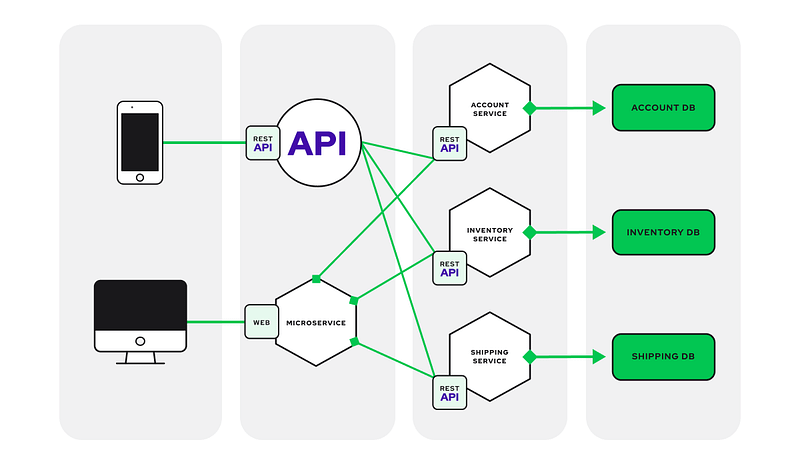
Introduction:
In the ever-evolving landscape of software development, the shift from monolithic architectures to microservices has emerged as a transformative force. In this comprehensive exploration of microservices, we’ll delve into the challenges presented by monolithic systems, the seamless communication mechanisms between microservices, and the myriad advantages that have propelled microservices to the forefront of modern software design.
The Pitfalls of Monolithic Systems:
Historically, when crafting intricate systems such as e-commerce platforms, developers would consolidate all functionalities — cart management, user authentication, payment processing, and shipment logistics — into a monolithic codebase. While seemingly convenient, this approach brought about a host of challenges. The sheer size and complexity of the codebase made it unwieldy, hindering the development process and impeding the system’s overall maintainability.
Issues Faced in Monolithic Architectures:
- Codebase Size: The accumulation of all services in a single codebase resulted in an unwieldy monolith. The codebase size became a bottleneck, making it difficult for developers to navigate, comprehend, and maintain.
- Maintenance Challenges: Implementing changes or fixing issues in a monolithic codebase posed significant challenges. Any modification could potentially ripple through the entire system, leading to unintended consequences and making maintenance a herculean task.
The Rise of Microservices:
Enter microservices, a paradigm shift that advocates the separation of individual services into independently deployable units. This decentralized approach mitigates the challenges posed by monolithic architectures, fostering a more modular and agile development process. Microservices are designed to operate as standalone entities, each responsible for a specific business capability.
How Microservices Communicate:
Microservices, despite their independence, need to communicate seamlessly to ensure the integrity of the entire system. There are three primary methods through which microservices communicate:
- TCP Calls: Microservices can engage in direct communication through TCP calls, establishing connections to exchange data. This method is efficient for scenarios where real-time communication is essential.
- Message Brokers: Message brokers act as intermediaries, facilitating asynchronous communication between microservices. This decoupled approach ensures that services can communicate without direct dependencies, promoting flexibility and scalability.
- Web Sockets: Web sockets provide a bidirectional communication channel, particularly useful for scenarios requiring real-time updates or continuous data streams between microservices.
Advantages of Embracing Microservices:
- Code Maintainability: Microservices offer a significant improvement in code maintainability. By breaking down a monolithic codebase into smaller, focused services, developers can manage and update specific functionalities without navigating an overwhelming codebase.
- Isolation of Failures: In the microservices architecture, the failure of one service does not cascade to impact other services. This isolation ensures that the overall system remains robust and functional, even if certain components encounter issues.
- Simplified Deployment: Microservices simplify the deployment process. Since each service operates independently, updates and changes can be deployed without affecting the entire application. This agility accelerates the development lifecycle and reduces downtime.
- Polyglot Programming: The flexibility to use different programming languages for various services enables diverse teams to work on different components. This polyglot approach ensures that teams can choose the most suitable language for a specific task, promoting collaboration and innovation.
- Agility, Scalability, and Efficiency: Microservices inherently bring agility, scalability, and efficiency to software development. The ability to independently scale services based on demand, coupled with rapid development and deployment cycles, allows organizations to adapt swiftly to changing requirements and market dynamics.
- Security Aspect: Microservices, when implemented with a robust security strategy, can enhance the overall security posture of an application. Security measures can be tailored to specific services, and vulnerabilities can be isolated and addressed without affecting the entire system.
Disadvantages of Microservices:
- Complexity: Microservices introduce a level of complexity in designing, implementing, and managing the interactions between services. This complexity can increase the learning curve for development teams.
- Data Management: Maintaining data consistency across distributed microservices and their individual databases can be challenging, leading to potential data integrity issues.
- Increased Resource Usage: The decentralized nature of microservices can result in increased resource usage. Each service requires its own resources, leading to potentially higher operational costs.
- Network Latency: Communication between microservices over a network introduces latency, which can impact the overall system’s performance, especially in scenarios requiring low-latency responses.
- Service Coordination: Coordinating actions across multiple microservices can be intricate, requiring careful design to ensure seamless collaboration without introducing bottlenecks.
- Testing Challenges: Testing microservices can be more complex compared to monolithic systems. Ensuring the integration and functionality of each service, both independently and collectively, demands a robust testing strategy.
- Deployment Complexity: Microservices may introduce deployment complexities, especially in scenarios where a large number of services need to be deployed and coordinated simultaneously.
- Security Concerns: The decentralized nature of microservices introduces potential security concerns. Each service must be individually secured, and vulnerabilities in one service may not be isolated from affecting others.
- Increased Operational Overhead: The decentralized nature of microservices can lead to increased operational overhead. Managing multiple services, monitoring, and orchestrating their interactions may require additional tools and resources.
Conclusion:
In conclusion, the adoption of microservices represents a pivotal moment in software architecture, addressing the limitations of monolithic systems. The ability to communicate seamlessly, coupled with advantages such as enhanced maintainability, isolation of failures, simplified deployment, and polyglot programming, positions microservices as a cornerstone of modern software development. As industries embrace agility, scalability, and efficiency, the era of microservices is set to redefine the way we build and maintain complex software systems.